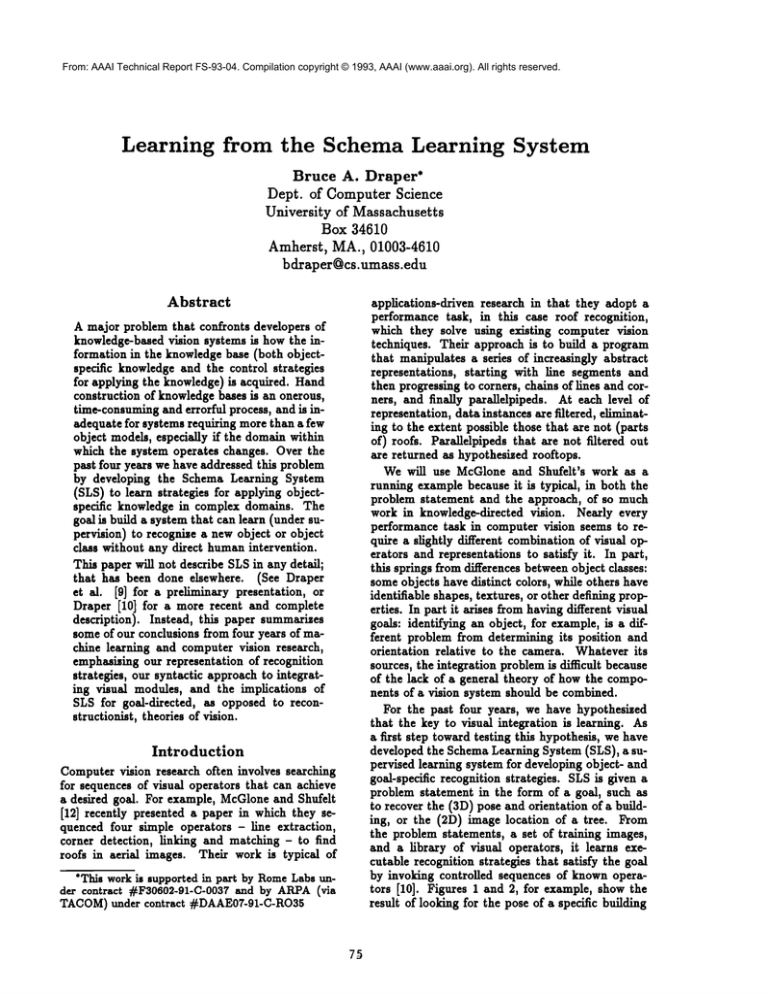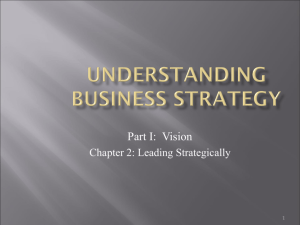
From: AAAI Technical Report FS-93-04. Compilation copyright © 1993, AAAI (www.aaai.org). All rights reserved.
Learning
from the Schema Learning
System
Bruce
A. Draper*
Dept. of Computer Science
Universityof Massachusetts
Box 34610
Amherst, MA., 01003-4610
bdraper~cs.umass.edu
Abstract
A majorproblemthatconfronts
developers
of
knowledge-based
visionsystems
is howtheinformation
in theknowledge
base(bothobjectspecific
knowledge
andthecontrol
strategies
forapplying
theknowledge)
is acquired.
Hand
construction
of knowledge
basesis an onerous,
time-consumlng
anderrorful
process,
andis inadequate
forsystems
requiring
morethana few
object
models,
especially
if thedomainwithin
whichthesystemoperates
changes.
Overthe
pastfouryearswe haveaddressed
thisproblem
by developingthe SchemaLearningSystem
(SLS)to learnstrategies
forapplying
objectspecificknowledge
in complexdomains.The
goalis builda system
thatcanlearn(under
supervision)
to recognize
a newobject
or object
classwithout
anydirecthumanintervention.
Thispaperwillnotdescribe
SLSinanydetail;
that has been doneelsewhere.
(SeeDraper
et al. [9] for a preliminary presentation, or
Draper [I0]for a more recent and complete
description). Instead, this paper summarizes
some of our conclusions from four years of machine learning and computer vision research,
emphasizing our representation of recognition
strategies, our syntactic approach to integrating visual modules, and the implications of
SLS for goal-directed, as opposed to reconstructionist, theories of vision.
Introduction
Computer
visionresearch
ofteninvolves
searching
forsequences
of visual
operators
thatcanachieve
a desiredgoal.Forexample,
McGlone
and Shufelt
[12]recently
presented
a paperin whichtheysequenced
foursimpleoperators
- lineextraction,
cornerdetection,
linkingand matching
- to find
roofs in aerial images. Their work is typical of
"This work is supported in part by RomeLabs under contract #F30602-91-C-0037 and by ARPA(via
TACOM)under contract #DAAE07-91-C-RO35
75
applications-driven
research
in thattheyadopta
performance
task,in thiscaseroofrecognition,
whichtheysolveusingexistin
vision
8 computer
techniques.
Theirapproach
is to builda program
thatmanipulates
a seriesof increasingly
abstract
representations,
starting
withlinesegments
and
thenprogressing
tocorners,
chains
oflinesandcorners,andfinally
parallelpipeds.
At eachlevelof
representation,
datainstances
arefiltered,
e]im|natingto theextent
possible
thosethatarenot(parts
of)roofs.
Parallelpipeds
thatarenotfiltered
out
arereturned
as hypothesized
rooftops.
We will use McGloneand Shufelt’sworkas a
running
example
because
it is typical,
in boththe
problemstatement
and the approach,
of so much
workin knowledge-directed
vision.Nearlyevery
performance
taskin computer
visionseemsto requirea slightly
different
combination
of visual
operators
andrepresentations
to satisfy
it.In part,
thissprings
fromdifferences
between
object
classes:
someobjects
havedistinct
colors,
whileothers
have
identifiable
shapes,
textures,
orotherdefining
properties.
Inpartitarises
fromhaving
different
visual
goals:
identifying
an object,
forexample,
is a differentproblemfromdetermining
itsposition
and
orientation
relative
to thecamera.Whatever
its
sources,
theintegration
problem
isdifficult
because
of the lackof a general
theoryof howthecomponentsof a visionsystemshouldbe combined.
For the pastfouryears,we havehypothesized
thatthekeyto visualintegration
is learning.
As
a firststeptoward
testing
thishypothesis,
wehave
developed
theSchemaLearning
System(SLS),a supervised
learning
system
fordeveloping
objectand
goal-specific
recognition
strategies.
SLSis givena
problemstatement
in theformof a goal,suchas
torecover
the(3D)poseandorientation
of a building,or the (2D)imagelocationof a tree.Prom
theproblem
statements,
a setof training
images,
ands library
of visualoperators,
it learnsexecutable
recognition
strategies
thatsatisfy
thegoal
by invoking
controlled
sequences
of knownoperators[10].Figures
1 and 2, forexample,
showthe
result
of looking
fortheposeofs specific
building
and the image location of a tree by reprojectlng
the hypotheses returned by learned strategies back
onto a test image. These recognition strategies replace those that computer vision researchers such
as McGloneand Shufelt currently build (at great
expense) by hand.
Figure 2: A tree located by a special-purpose strategy learned by SLS. The goal of the strategy is to
find the (2D) image location of trees.
Verified hypotheses (or, more accurately, hypotheses that have not been rejected) are then transformed to s more abstract level of representation,
where a new verification process takes place. The
cycle of transformation followed by verification continues until hypotheses that satisfy the goal (i.e.
the problem statement) have been generated and
verified.
The structure of the recognition graph reflects
the verification/transformation cycle. Each level of
a recognition graph is a decision tree that controls
hypothesis verification at one level of representation
by computing selected features and determining if
the corresponding hypothesis is reliable. Whena
hypothesis is verified it is transformed (by a transformational operator) it to another level of representation, where the process is repeated.
That each level of a recognition graph is a univariate decision tree is not particularly important.
Anytwo-class classifier can be used, and we are currently developing recognition graphs that use artificial neural networks and multivariate decision trees
instead. (One could also build a hybrid system that
selected the best classification induction algorithm
for each level of abstraction, a la Brodley [7].) It is
important, however, that the classifier have a very
low false negative rate. At all but the highest level
of abstraction, if a classifier verifies a false instance
the mistake will most likely be corrected when the
instance is transformed to the next level of representation. If a classifier rejects a correct instance,
on the other hand, it is a miRtake that the system
Figure I: The pose of the Lederle Graduate Research Center (LGRC),reprojected onto the image
it was recovered from. The pose was recovered by a
special-purpose strategy learned by SLSfor determining the position and orientation of the LGRC.
Wewill not describe the learning algorithms used
by SLS here; interested readers are refered to my
dissertation [101. Instead, we will present informal
conclusions drawn from our experience with SLS,
focusing on items that maybe of interest to other
researchers in the area of machine learning and vision.
Representing
Recognition
Strategies
To the extent that SLSis successful, it is successful
because of its representation of recognition strategies. SLSrepresents strategies as multi-level decision trees called recognition graphs that are generalised to direct hypothesis formation as we]] as hypothesis verification (see Figure 3). The premise
behind the formalism is that object recognition
is a series of representational transformations interleaved with small verification tasks. Strategies
begin by extracting low-level hypotheses, such as
points, lines, or regions, from an image. Then
recognition strategies verify these (low-level) hypotheses, separating to the extent possible hypotheses that are reliable from those that are not.
76
straints. Although such an approach is very powerful in theory, it is difficult, if not impossible, in
practice.
SLS, on the other hand, takes an essentially syntactic approach to visual integration. It starts with
a library of visual representations and transformational operators. For each representation, the library contains a list of measurable features and
routines for measuring them. For example, the
library entry for line segments specifies that they
have endpoints, length and contrast, and gives the
datatype of each. For transformational operators,
the library specifies the type of representation(s)
required as arguments and the type of representation produced, so that a line extraction operator,
for example, takes an image as input and produces
line segments as output. The library also contains
default values for any compile-time parameters a
transformational operator might have. The library
does not contain estimates of the cost or reliability
of an operator, since we discovered that our estimates of such values tended to be highly inaccurate.
Obviously, the purely syntactic approach has
some disadvantages. SLS operates at the level of
an automatic programming system, with no special knowledge about physics or optics or geometry. The advantage of the syntactic approach, however, is that it allows SLSto integrate widely disparate operators and representations, so that a single recognition strategy can exploit manydifferent
types of information, including but not limited to
color, texture, shape, size, context and function. It
also allows new operators and representations to be
added to the system as they are developed.
Levelof Representation:N
Figure 3: A recognition graph. Levels of the graph
are decision trees that verify hypotheses by measuring their features. Hypotheses that reach subgoals
are transformed to the next level of representation
by transformation operators.
cannot recover from. Consequently, the classifiers
in SLSare trained to produce manymore false positives than false negatives in order to maTimizethe
overall performanceof its strategies.
The significance of the recognition graph formallsm is that it biases the learning algorithms toward the types of strategies that humanknowledge
engineers have found to be successful McGlone
and Shufelt’s system, for example, maps directly
onto the recognition graph formalism: they use four
transformation operators (image to line segments,
line segments to corners, corners and line segments
to chains thereof, and chains of lines and corners to
parallelpipeds), and after each transformation they
filter out unreliable hypotheses. The recognition
graph is also significant because it cast the learning problem as one of both classification and symbolic (transformational) inference. To our knowledge, members of the machine learning community
have looked at both classification and symbolic inference, but not at the combination of the two.
Syntactic
A Theory of Vision
According to the Encyclopedia of Artificial Intelligence, "the goal of an image understanding system
is to transform two dimensional data into a description of the three dimensional spatiotemporal
world." [13, pg. 389]1 Such definitions reflect the
influence of Mart and the reconstruc~ionis~ school
of computer vision [11], which holds that vision is
the process of reconstructing the three dimensional
geometry of a scene from two dimensional images,
essentially by inverting the geometry and physics
of optical perspective projection. Symbolic recognition is viewed as a secondary process that follows
and is dependent upon geometric reconstruction.
There is, however, an alternate definition of computer vision, in which the goal is to enable actions, generally by applying concurrent, specialpurpose strategies. This goal.directed approach has
roots in the psychology literature of the 1960’s and
Approach to Integration
In terms of the integration of visual modules, SLS
is on the opposite end of a spectrum from the approach taken by Aloimonos and Shulman [1]. Aloimonos and Shulman recommend analysing the semantics of each visual operator closely, and integrating them by merging their mathematical con-
1Althoughthe citation is to the orig~nMsource, we
discovered this quotation in the introductory paragraph
of DanaBaUard’sarticle on animate vision [6].
77
scientific breakthroughs than on formalizing common knowledge. Although many systems use handcoded knowledge to integrate visual modules, and
although the techniques of writing such systems in
terms of reasoning across multiple levels of abstraction and the "generate and test" paradigm are well
known, no other system puts them together into a
formalismlike the recognition graph, or tries to bias
learning to produce such strategies. Indeed, the
very idea of approaching visual integration at the
level of automatic programming was anathema to
manywhoprefered to think in terms of physics, optics or geometry. Despite its pragmatic approach,
however, SLS ends up making a contribution to the
general theory of computer vision by helping crystallize the alternative to Mart: vision as a collection
of special-parpose skills acquired in response to the
environment.
At the same time, the machine learning community has tended to study classification
and symbolic inference as distinct problems, even though
interpretation tasks such as vision seem to require
a combination of the two.
the cybernetics literature of the 1940’s and ’50s.
(See Arbib [5] for a review.) What is particularly
compelling about this approach, however, is that
it keeps resurfacing in the computer vision Iiteratare with different motivations. It first appeared
in the early 1970’s in the work of Arbib, who modeled perception in terms of action-oriented schemas
[3, 4]. Several years later, Brooks proposed a layered approach with each layer integrating perception ¯ nd action as a solution to problems of realtime robotics [8]. Similar ideas surfaced again in
the work of Aloimonos, who was trying to circumvent the practical difilculties ofreconstructionist vision [2], and Ballard, who, like Arbib, was modelLug biological vision [6]. Partly as a result of this
repeated convergence, the notion of vision as a collection of concurrent, special-purpose strategies is
once again gaining popularity.
Webelieve SLS gives a boost to theories of goaldirected (a.k.a. purposive) vision. Such theories
have been criticized by researchers of the reconstructionist school whoargue that the goal of computer vision research is not just to create object
recognition systems, but to put forth a coherent and
parsimonious theory of vision. These researchers
dalrn that by modeling vision as a loose (to be
critical, ad hoc) collection of special-parpose recognition systems, proponents of goal-directed vision
abandon that goal. SLS puts forth a counterclaim
by example, however; a c]alm that special-parpose
recognition strategies do not have to be ad hoc
or unstructured, that they can arise through predictable and scientific mechanismsin response to a
viewer’s environment. Indeed, the criticism can be
turned around: given that special-parpose strategies can be acquired through experience, it seems
unnecessary and unjustified to assume that all visual goals must be met by a single general-parpose
mechanism.
Future
References
[1] J. Aloimonos and D. Sh-lman. Integration o/
Visual Modules: An Eztension of the Mart
Paradigm. AcademicPress, Inc., Boston, 1989.
[2] J. Aloimonos. "Purposive and Qualitative Active Vision," Proc. of the DARPAImage Understanding Workshop, Pittsburgh, PA., Sept.
1990. pp. 816-828.
[3] M.A. Axbib. The Metaphorical Brain: An Introduction to Cybernetics aa Artificial Intelligence and Brain Theory. NewYork: Wiley Interscience, 1972.
[4] M.A. Arbib. "Segmentation, Schemas, and Cooperative Computation," Studies in Mathematical Biology, pt. I. S. Levin (ed.). MAA
Studies in Mathematics, vol. 15, 1978, pp. 118155.
[5] M.A. Axbib. "Schema Theory," in The Encyclopedia of Artificial Intelligence, 2nd ed.,
S.C. Shaprio (ed.) NewYork: Wiley and Sons,
1992, pp. 1427-1443.
Work
Research on the Schema Learning System is by no
means finished. Ongoing efforts include work on
1) integrating systems that learn structural object
models (such as structure from motion algorithms),
2) automatically learning parameter settings for visual operators (see Bhandaru, et al., this volume),
and 3) combining dynamic and static control of visual operators. Longer term goals include reducing
the amount of supervision needed during training,
having SLS determine its own object classes, and
learning concurrent special-parpose strategies that
cooperate to interpret a complete scene.
[6] D.H. Ballard. "Animate Vision," Artificial Intelligence, 48:57-86 (1991).
[7] C.E. Brodley. "Addressing the Selective Superiority Problem: Automatic Algorithm/Model
Class Selection," Proc. of Tenth International
Machine Learning Conference, June 27-29,
Amherst, MA., pp. 17-24.
Conclusion
[8] R.A. Brooks. "Intelligence without Representation." Proc. of the Workshop on the Foundationo of Artificial Intelligence, Cambridge,
MA.: MIT Press, 1987.
SLS is an example of using machine learning technology to solve a pressing problem in computer vision. Its success, however, depends less on radical
78
[9] B. Draper, A. Hanson and E. Riseman.
"Learning Blackboard-based Scheduling Algorithms for Computer Vision," International
Jou~aal o/ Pattern Recognition and Artificial
Intelligence, 7(2), 1993.
B.
Draper. Learning Object Recognition 5 trate[10]
g/es. Ph.D. dissertation,
Univ. of Msssschusetts, 1993. Avsilable as tech. report 9350 from the Dept. of Computer Science.
[11] D.C. Marr. Vision. San Francisco: W.H. Freeman and Co., 1982.
[12] C. McGlone and J. Shufelt. "Incorporating
VaniRhing Point Geometry Into a Building Extraction System," Proc. o.f the ARPAImage
Understanding Workshop, Washington, D.C.,
April 1993. pp. 437-448.
[13] J.K. Tsotsos. "Image Understanding," in The
Encyclopedia of Artificial Intelligence, first
edition, pp. 389--409. 1987.
79



